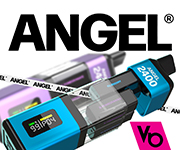Urvapin
Postman
- Joined
- Oct 22, 2016
- Messages
- 920
Entering the second season of 2017, the RDTA structured products are largely thrown to the vaping groups after the stagnation in last year. A large quantity of new RDTA emerged in the market. Echoing to this development tide, Syntheticloud company recently launched a RDTA, named Alpine RDTA, which is a RDTA of 24mm diameter with top and bottom airflow holes. Here below I will bring you guys the usage experience of this RDTA.
It is packed in an Acylic box. The sign of SC company and the atomizer can be seen clearly. At the bottom, there is labeled with some product information concerning the atomizer, for example, central fill, 3ml juice capacity, 24K gold plated internals and so on.
Simply in the light of appearance, Alpine RDTA still remains the appearance features of AEOLUS RDA. There are no heating coils suggested by the official. Except for the atomizer, there is only the spare o-rings, electrode screw and glass tube.
To a large extent, the top airflow hole represents the series of AEOLUS RDA. But on the Alpine RDTA, you can find air inflow hole at the bottom. Generally, concerning air inflow holes like this both on the top and at the bottom, the bottom air inflow holes plays a main part and the top air inflow hole part plays a secondary part. In a greater extent, the top airflow hole plays a role in assisting the heat dissipation.
The daily disassembling is divided into six parts. The upper parts are the electro black ones and the lower parts are the electro gilding ones. The lower parts is very convenient for the daily operation. Under the situation that the glass tube and the bottom parts are not installed, you can also make the coil and heat the coil. And after you fill in the cotton, you can scatter the cotton and then install it back to the glass tube and the base parts.
The drip tip connects the air inflow slot. At the connection of the drip tip (POM) and the top cap (medal), there is no o-ring to produce damp. The top parts open totally with six round air inflow holes. Between the two lines of inflow holes, you can see the “plug”of the filling hole at the vapor entrance. In the using of this atomizer, the top of the glass tube can easily collect the condensate liquid. Every time when you finish the oil in the tube, you will need to clear the tube with tissue.
Totally, there are three components on the gold-plated plate, and the gold-plated plate has a “L” inflow at the bottom. You can see the filling post in the middle connecting to the juice tank at the bottom, and the “plug”of the top cap assures the bubble-tight closure to the flow. I believe, such reliable and simple operation for refilling will be adopted by more RDTA manufacturers. Namely, homogeneity will still appear.
The dual posts, cross-screw for locking the coil, the opening degree of the coil-locking hole shows that this RDTA can be compatible with the fancy coils. But in the light of the span of the bottom inflow holes and the space between the refilling holes, the designer seems to have limited the width of the fancy coil a little bit.
Under the tide of Clapton heating coil, according to the samples released by the official, you can see many high-end Clapton coils are used on this RDTA. Based on actual usage and from the angle of simple purchase, the 24G, 26G,38-40G Clapton Coils are used the most. The usage experience will be depicted at the end of this article.
The A1 traditional single coil user can choose the 22G Coil. Using 22G coil on this RDTA can produce better original oil flavor than the 21G and 24G coils can do. All the G points will only appear on the condition that the top inflow holes are closed completely.
After actual use of the Alpine RDTA, I feel it not only keeps its traditional design of top inflow, but also adds bottom inflow. Such design brings more playing methods to the coil choices to this atomizer. However, whether the top and bottom inflow holes need to be opened at the same time or how to be allotted, much reasonability is needed.
1. Using the top inflow and bottom inflow separately, 90% players would choose the single bottom inflow. Thus, the method of single top inflow can be excluded.
2. When playing the role for assisting lowering the heat, top inflow can help to lower the heat, but unavoidably it will have an effect on diluting the flavor of the oil and the density of the vapor. Such as the Clapton coils mentioned in the previous text, after 4 or 5 mouths of inhaling, you will feel the atomizer is heavily hot. After you open the top inflow hole to lower the heat, the heat can be well controlled, but the density of the oil and vapor will be greatly reduced.
3. Using the traditional A1 coil of 22G can reach my best G point, on condition that the top inflow hole is closed. On such condition, this atomizer shows smooth resistance, the flavor of the oil can be restored evenly. After using for a while, the bottom part of the top cap will accumulate some condensed liquid and will need to be cleaned. Except for this, there is no other obvious defects.
After building the coil, I put in the wick and cut it off to a proper length. Then I put the ends into the holes on the plate and use the tweezers to fluff the wick a little bit. Personally, the wicking technique of this Alpine RDTA is really impressive after my try on it.
In summary, the appearance of this Alpine RDTA tank can be matched with nearly all tanks. The appearance of this tank can cater to many players. Regarding to the inflow design of this tank , the single bottom inflow playing method can be better than the mixed top and bottom inflow playing method. The top refilling system is a very good example for RDTA and the wicking on this tank is the best!
https://www.urvapin.com/blog/usage-experience-of-alpine-rdta-tank-simple-refilling-and-best-wicking/

























